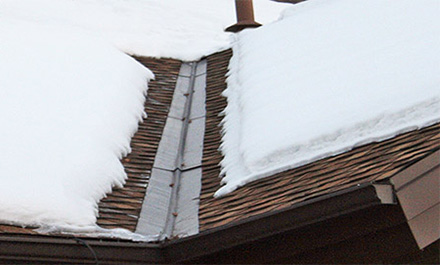Pittsburgh Roof Heating Systems
 Warmzone roof heating systems have proven to reliably protect roofs and gutters from the typical
winter threats of ice dams and heavy ice buildup in gutters and downspouts. Most roofs are well
constructed and can bear surprising weight loads, so having a foot or two of snow on the roof is no
cause for concern. However, one very discreet culprit lurks on most roofs, and because it's the one
that can result in the most costly damage, it’s one that we all should be aware of.
Warmzone roof heating systems have proven to reliably protect roofs and gutters from the typical
winter threats of ice dams and heavy ice buildup in gutters and downspouts. Most roofs are well
constructed and can bear surprising weight loads, so having a foot or two of snow on the roof is no
cause for concern. However, one very discreet culprit lurks on most roofs, and because it's the one
that can result in the most costly damage, it’s one that we all should be aware of.
In most homes small amounts of heat can escape from the living area up into the attic. That warm air, however slight, can still be enough to warm the roof and cause the bottom layers of snow to melt. The water trickles down the roof, but when it reaches the colder roof eaves it refreezes. The first instances of this result in a small ridge of ice forming at the beginning of the roof eave. Over time the process repeats itself and the ridge of ice begins to grow. Still, the homeowner may not notice that there is a problem. Eventually the ice ridge is large enough that it causes water to pool behind the ice dam.
Roofs are not intended for standing pools of water. Water can seep into the smallest of cracks in shingles or areas around nails or flashing. When that water refreezes at night it expands. This is what can lead to breaking down the integrity of the roof. If ice dams are a regular occurrence year after year water may eventually find its way inside the home. In some cases the water may seep inside walls and remain undiscovered for years. By the time the damage is revealed the wood and drywall may not be the only problem. Dangerous mold can spring up as a result of water damage from undiscovered ice dams.
Some things that Pittsburgh homeowners can do is to make sure that the attic is well insulated and the ceiling has no cracks or structural issues whereby heat may escape. To deal with ice dams after the first snowstorms hit, some homeowners use a roof rake to clear snow or breakdown ice dams, but care must be taken when doing this to avoid damaging the shingles. And the task must continually be performed throughout the winter.
Warmzone offers a variety of roof deicing options that virtually eliminate ice dams. And the systems can be easily customized to accommodate your roof design and your budget.
 The Warmzone RoofHeat STEP roof deicing system is a low-voltage system that is a favorite roof deicing
system for growing numbers of roofing professionals. Proven effective for almost 20 years, RoofHeat STEP
features a thin, semi-conductive polymer heating element that is installed discreetly under the shingles.
It is also safe for heating metal roofs. Available in widths of 9 and 12 inches (as well as thin strips
for gutter heating) the heating element can be nailed or stapled through during installation. The flexible
heating panel is polypropylene fused during fabrication to achieve water proofing and protect it from
alkaline or salt damage. The system utilizes transformers to step down high voltage to low voltage (60
V or less) voltage. It is regarded as the optimum roof deicing solution for heating roof edges and valleys.
The Warmzone RoofHeat STEP roof deicing system is a low-voltage system that is a favorite roof deicing
system for growing numbers of roofing professionals. Proven effective for almost 20 years, RoofHeat STEP
features a thin, semi-conductive polymer heating element that is installed discreetly under the shingles.
It is also safe for heating metal roofs. Available in widths of 9 and 12 inches (as well as thin strips
for gutter heating) the heating element can be nailed or stapled through during installation. The flexible
heating panel is polypropylene fused during fabrication to achieve water proofing and protect it from
alkaline or salt damage. The system utilizes transformers to step down high voltage to low voltage (60
V or less) voltage. It is regarded as the optimum roof deicing solution for heating roof edges and valleys.

Self-Regulating Heat Trace Cable
Another effective and very affordable option is to install self-regulating heat cable. The cable can be zigzagged along the roof’s edge to provide channels for runoff (eliminating pools of water from behind ice dams) as well as routed through gutters and downspouts to provide an unobstructed path for runoff.
For years Warmzone has designed roof heating systems for homes and commercial structures. We understand what it takes to provide cost-effective solutions to prevent winter roof problems. Contact a Warmzone roof heating expert today to learn more about the many roof heating options that are available at 888.488.9276.
